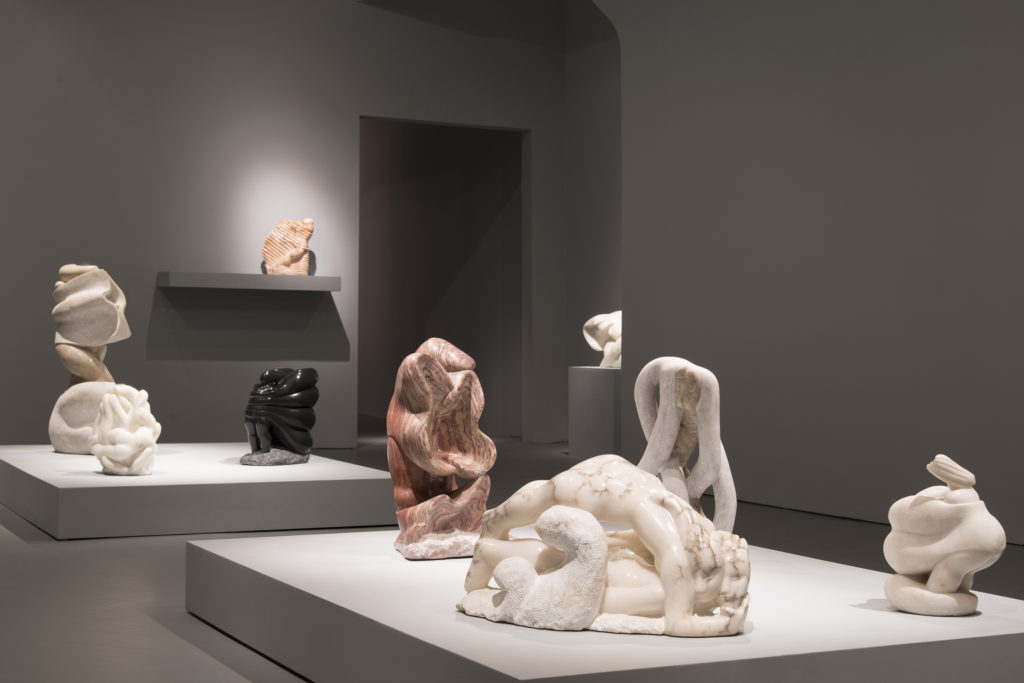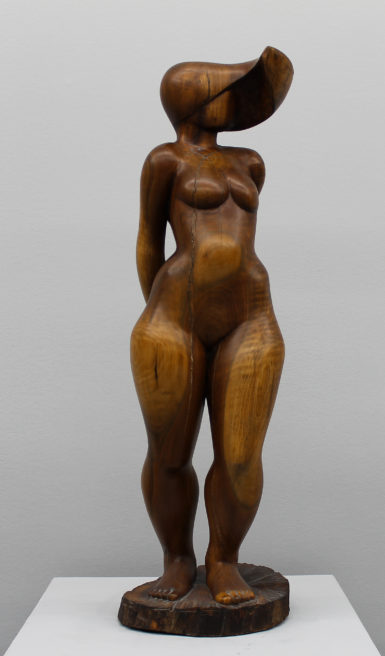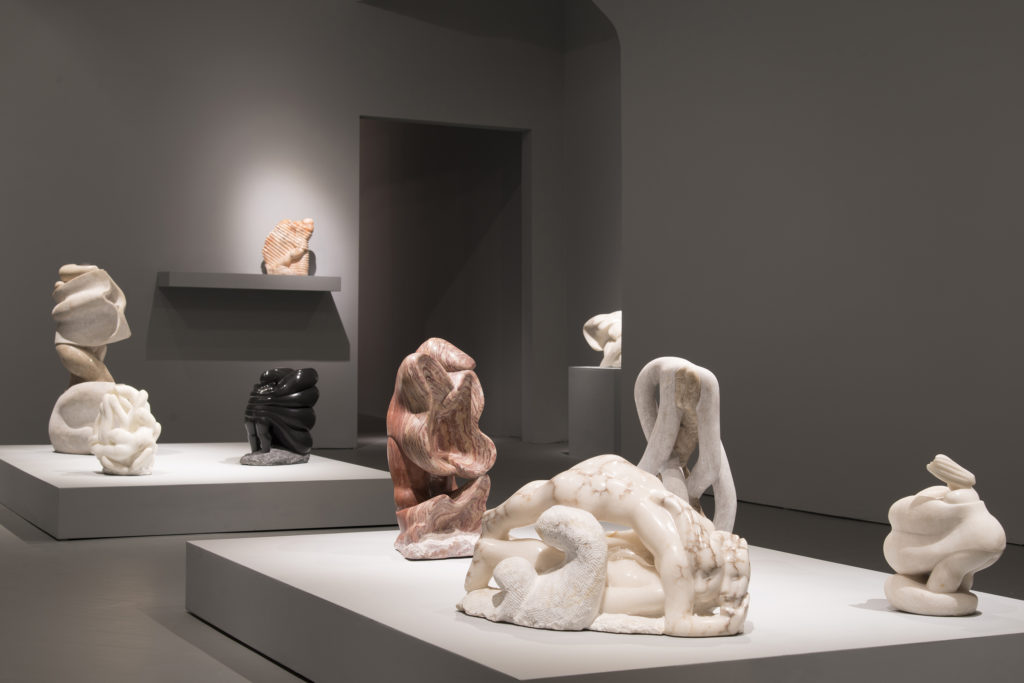[ad_1]

Installation view of “Kay Hofmann: pour toujours,” 2019, at Patron gallery, Chicago.
COURTESY THE ARTIST AND PATRON GALLERY
There is something about stone that has always moved artist Kay Hofmann. For the past six decades, the Rockford, Illinois–based sculptor has worked that material with her hands, shaping marble, alabaster, and granite into graceful forms that resemble women in motion. Often swathed in billowy folds, her semi-abstract figures appear as emergent forces, caught surfacing from their carapaces.
On a recent weekend at Chicago’s Patron gallery, where she’s having her first commercial show in 30 years (through Sunday), Hofmann tried to explain the compulsion that birthed the gleaming pieces that surrounded her. “I can look at a piece of stone for five minutes, and oh my god, there’s something already in there,” she said. “I just can’t help but do what I do.”
Now 86, Hofmann continues to work every day. She can regularly be found hauling heavy material into her studio, despite her grandson’s exasperated pleas that she stop doing this. She still eschews power tools, and she showed me one of her thumbnails, which she keeps long, so that she can wrap it in sandpaper for polishing creases in the stone she uses. “People think I’m crazy that I don’t have Dremels [tools frequently used to shape stone], but you don’t feel the same with those,” she said.
Her Patron show, “pour toujours,” features six decades of sculptures, many of them belonging to a tender series of gliding swimmers and voluminous, striding figures. The newest work in the exhibition, Coils of Love (2018), is a delicate bundle of pink alabaster coils that conceals a woman appearing to break free. “I always wanted to show a woman being strong, moving forward,” Hofmann said.

Kay Hofmann, Coils of Love, 2018, hand-carved alabaster.
COURTESY THE ARTIST AND PATRON GALLERY
It’s an apt description for the sculptor, who, over the past few years, has enjoyed a late-career renaissance. While Hofmann has exhibited across the Midwest, it’s been a while since she’s had an opportunity to show work. But in recent years, she’s become a darling of the Chicago art scene, as younger generations see her sculptures for the first time. That fervor for her work was on full display at the opening for her Patron show, which, despite a snowstorm on the evening it was held, drew locals in droves.
The artist’s revival began in 2016, when Mary Eleanor Wallace, the owner of the Chicago-based boutique and gallery Tusk, met Hofmann to buy marble pedestals that the artist was selling on Craigslist. “She went ape!” Hofmann recalled. “She said she’d love to have some pieces in her gallery, so I said sure.” That summer, Wallace invited Hofmann to Tusk for dinner, and when the artist got there, Wallace revealed a surprise: an opening for a full-on show of Hofmann’s sculptures. “There was nothing there but my pieces,” she said, still in awe. “There were so many people, you couldn’t even walk.”
Hofmann had her next solo show in 2017 at the artist-run gallery 4th Ward Project Space. Its cofounder, Mika Horibuchi, who is represented by Patron, urged her gallery’s directors to see Hofmann’s work. “We knew then that a sleeping giant had awoken before us,” Julia Fischbach and Emanuel Aguilar, the founders of Patron, told ARTnews.

Kay Hofmann, Pride/with my tools, 1980s, hand-carved black walnut.
COURTESY THE ARTIST AND PATRON GALLERY
Hofmann was born in 1932 in Green Bay, Wisconsin, where she began sculpting at age three. “My dad would find clay in the garden and bring it to me,” she said. “I used to [sculpt] every dog in the neighborhood, and everybody got horses for Christmas.” When she enrolled in the School of the Art Institute of Chicago, Hofmann initially kept working with clay, but then realized that she “hated making things, tearing it apart, and doing it over,” she said. She started bringing old pieces of graves—a nod to her father’s work as a stonecutter specializing in tombstones—into her studio to carve into heads, mothers, and families.
After graduating in 1955, she received a fellowship in Paris, where her work veered into abstraction. A seminal piece in the Patron show is her first wood sculpture, carved from a hunk of horse chestnut tree she found cut down on the Champs-Élysées. The near-two-foot-tall figure is totemic, with its grooved surface revealing Hofmann’s sensitivity to her humble material’s physical properties.
“I never really wanted to do realism,” she said, gesturing to the most figural piece in the show, a voluptuous female figure she made in the ’80s from black walnut. But that started, she added, in 1979, when Playboy founder Hugh Hefner commissioned Hofmann to sculpt a woman holding a tray. (The work was carved into a staircase in Hefner’s bedroom in Los Angeles.) “He kept saying, ‘A little thinner, a little less around the waist,’ ” Hofmann recalled. Then she dropped her voice to a whisper, and added, “I really didn’t enjoy doing it. Anyhow, that’s where he put his Pepsi and robes every time he went up to his erotica room, where he had his Picassos.”
Though she’s completed other portrait commissions, she’s drawn to more poetic expressions of sculpture—“things that flow into each other,” in her words. Indeed, her most beguiling pieces are those that appear, from one angle, abstract, like geographic formations hewn by wind or water, and, from another, figurative.
Hofmann once ran a toy store called Forever Young—a motto she’s continued to live by, and one that has inspired the titles of her shows at 4th Ward Project Space and Patron. Her work, too, has eternal capacity to enchant. When asked why she thought her sculptures resonate so deeply today, her answer was immediate. “It’s not what’s being done,” she said. “People are creating maquettes and sending them to Italy for carving. They don’t know how fun [sculpting by hand] is. . . . There’s nothing better than hacking into stone.”
[ad_2]
Source link

